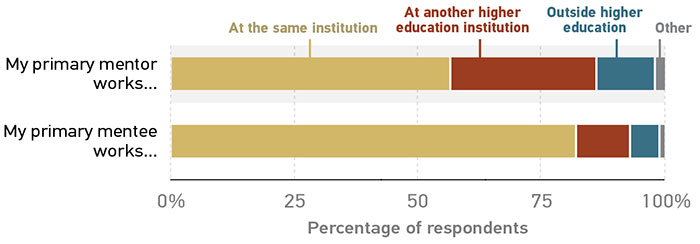Establishing Mentoring Relationships: Start in the Workplace, but Don't Get Stuck There
When we think of a mentoring relationship, we may visualize a protégé or mentor working with us in the same workplace, addressing similar issues, challenges, and opportunities. However, if you're working at a smaller institution, with a small IT department, your opportunities for a mentoring relationship might be severely restricted. But that doesn't necessarily mean you're not going to be able to engage with a protégé or mentor. We found that although a majority of protégés and mentors worked at the same institution (figure 3), differences in location were noted across organization level and institution type. This indicates that viable pathways to mentoring relationships are not solely centered on institutional opportunities.

CIO mentors had the highest percentage (21%) of protégés working at another higher education institution. CIOs possibly have larger networks to draw from to engage with potential mentees, likely due to the unique career pathways of CIOs and their cross-institutional networks. Additionally, CIOs are likely to have had to move to another institution to obtain that position.1 This may facilitate more external connections for current or future CIOs, due to their travel to other institutions, conference attendance, and the networking opportunities these activities provide. This sets up a wider network for CIOs, who likely have continued links to the institution(s) where they began their career. For CIOs (or CIO aspirants) who work at smaller institutions, leveraging their external networks to identify potential protégés or mentors may overcome the barrier of having smaller pools of employees with whom to engage in mentoring relationships.
Significant differences were found between organizational levels (CIOs, managers, and staff) and where protégés' mentors work. Most CIOs' mentors work at another higher education institution (59%) or outside higher education (21%). However, for managers and staff, seeking a mentor at their home institution may be more effective due to the shared insight into the workings of the organization or understanding how to grow a career within a particular institution. A majority (60%) of managers' mentors work at their institution, while fewer than a third (28%) of managers' mentors work at another higher education institution, and relatively few are outside higher education (12%). By the same token, three-quarters (75%) of staff's mentors work at their institution, while 17% work at another institution and 8% work outside higher education.
Employees at smaller schools may need to reach out beyond their organization to establish mentoring relationships because the IT workforce at these institutions is usually small. Mentors who work at a BA institution, compared with other institution types, had the largest percentage (26%) of mentees working at another institution. Similarly, AA (70%) and BA (67%) protégés had higher percentages of mentors working at another institution, compared with around 20% for protégés at MA or DR institutions. In the same vein, mentors at smaller institutions (fewer than 4,000 FTE) had more primary protégés working at a different institution or outside higher education.
Smaller institutions may need to consider becoming more intentional about mentoring for those employees who do not have extensive professional networks to draw from for mentoring. More strategically, CIOs can strengthen relationships with nearby institutions to promote "mentoring exchanges" and work within consortia to enlarge the field of possible mentoring participants. Since CIOs often come to their current position from different institutions,2 they may be able to effectively leverage their networks to increase mentoring opportunities for their staff.
Mentors outside the protégés' institution can be beneficial because they may offer objective and honest opinions to their mentees. Such mentors face little or no political risk when offering perspectives on the experiences of mentees.3 For similar reasons, mentees may also feel comfortable speaking to someone outside their institution, as it decreases risk-taking within the relationship and may open up a more honest discussion about the protégés' current institution and career goals.
Notes
-
Galanek, Gierdowski, and Brooks, The Higher Education IT Workforce.
↩︎ -
Ibid.
↩︎ -
Anne Perschel, "Do You Need an In-House or an External Mentor?," Forbes, July 21, 2014.
↩︎